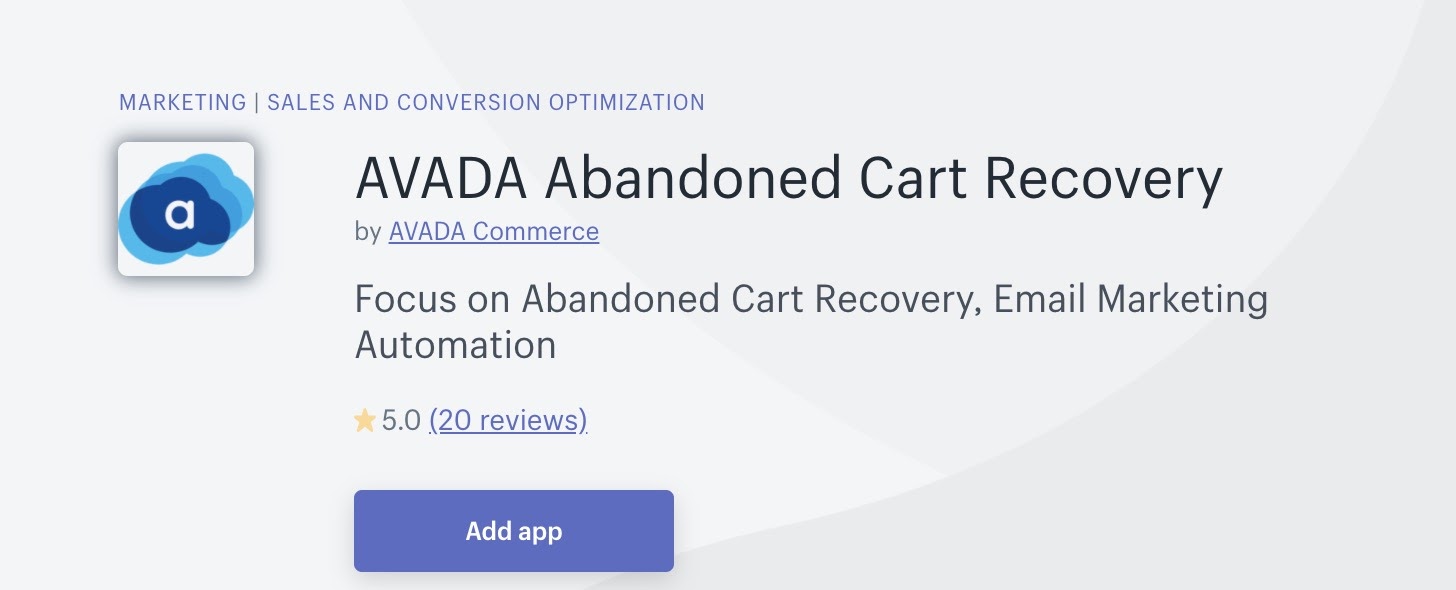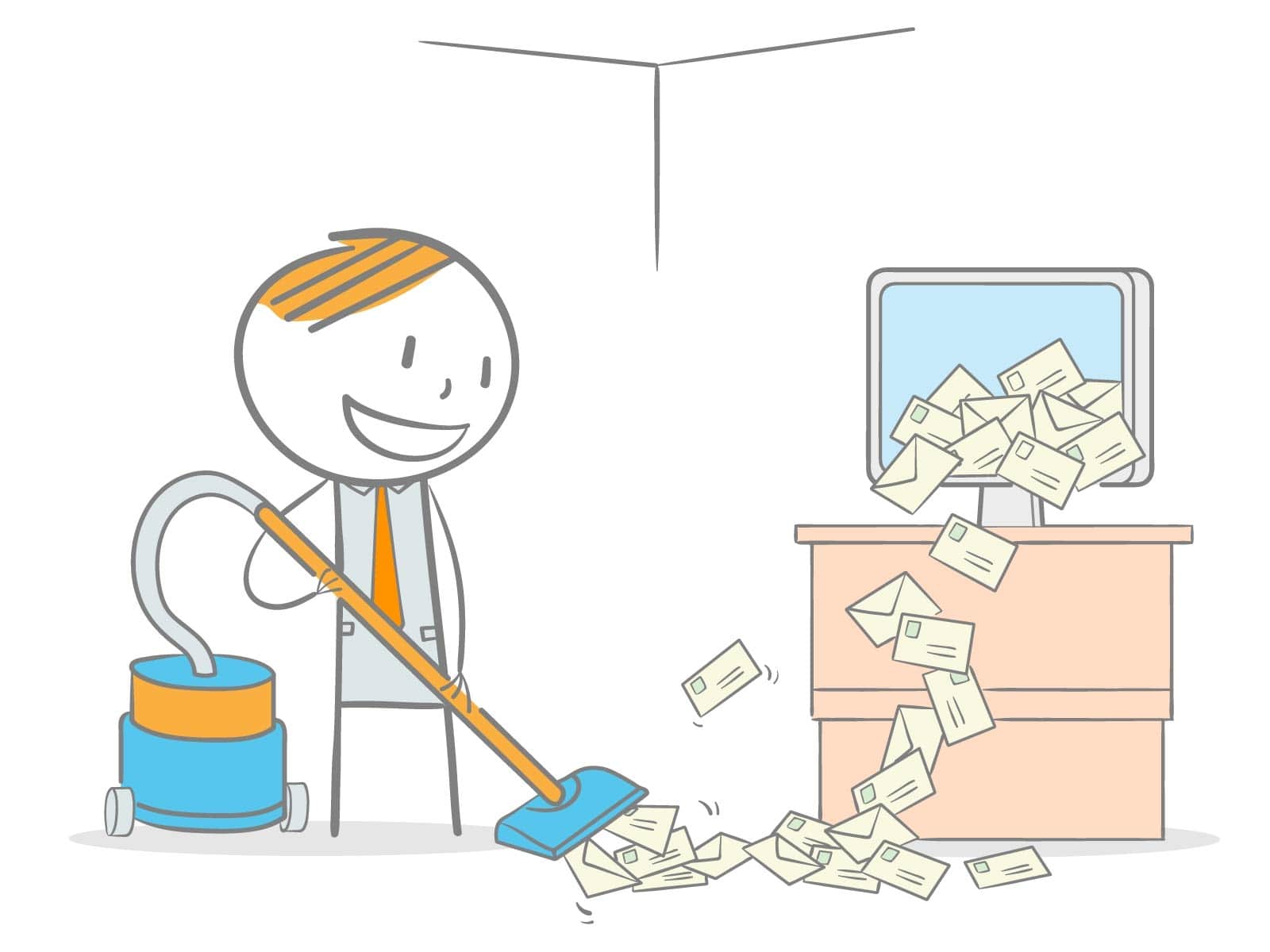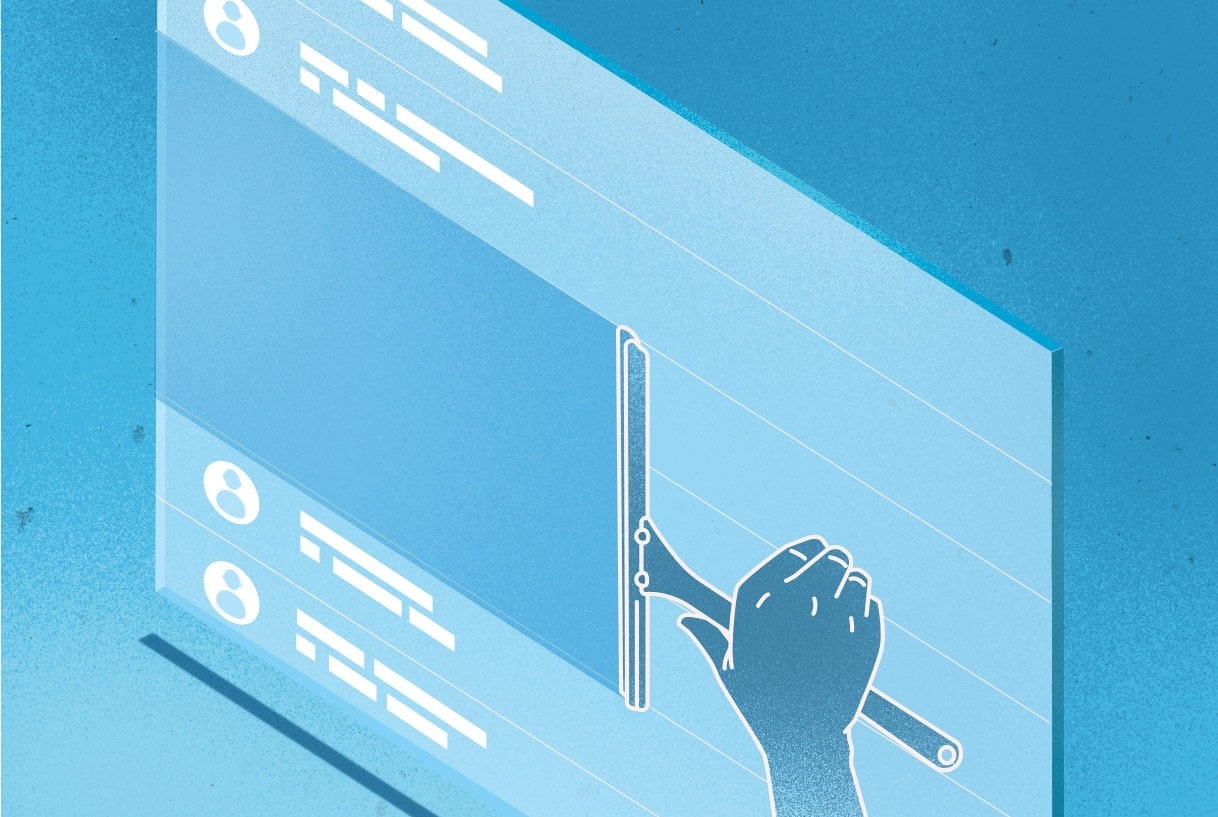Why Should you Clean your Email List? When & How to do it?
You’ve grown your email audience to a massive list of subscribers. It’s time now to clean it up and get rid of those subscribers who no longer generate profits. Cleaning up your email list will boost three main metrics: deliverability, open rates, and click rates. The better these metrics are, the more successful your future email marketing campaigns will be. That’s because a smaller number of dedicated subscribers — people who regularly read and engage with your content and brand — are more important than a larger list of subscribers who never open your content.
In reality, lists with tons of inactive email addresses usually have higher bounce rates, spam complaints and unsubscribe rates than those that do not. Plus, if you keep sending emails to people who don’t open them, internet service providers — like Gmail, Hotmail, and Yahoo — will penalize you. Do this frequently enough, and your emails can automatically end up in the spam inbox, which reduces the opportunity to deliver to people who actually want to receive your content.
And how often do you need to clean up your email list? It’s going to vary from list to list, but a decent rule of thumb is every six months — and certainly not more than a year. Getting rid of subscribers can sound frightening, but a smaller list of highly engaged subscribers is far more valuable to you than a larger list of subscribers who never open your emails. Are you ready to get started? Here’s a comprehensive guide to why you need to clean up your email list and how to do it.
What is email list cleaning?

Simply put, cleaning your email list is the process of removing inactive or invalid email addresses out of your email list. This is achieved by deleting all subscribers who have not opened any of your emails in a certain period of time (for example, the last six months). These emails are often referred to as ‘cold’ subscribers.
On a side note, before having to clean your email list, you need to have an email list to begin with. If you haven’t got a tool to collect emails from your audience, try out AVADA Email Marketing. Our app allows you to collect your audience’s emails with beautiful pre-made templates, segment the leads you have captured, and automate many repetitive tasks. More importantly, it’s FREE! Go and grab it for your Shopify store.

Read more:
- 10 Proven Email Automation Workflows
- How To Do Targeting On Your Email Marketing Campaigns?
- How To Write Cross-sell Emails?
- 10 Upsell Email Templates That Strongly Convince
Why do you need to clean your email list?
Email lists tend to decay over time. Not all email addresses on your list will last forever. The reason varies. It can be because a lead signed up with a work email, but then changed his/her job. Or they just don’t use this particular email account anymore. Then there is the problem of inactive, or ‘cold,’ subscribers. These are the contacts who have signed up to your mailing list but have not opened a single email from you.
Neither of these types of contacts contributes to a lucrative email list. By freeing your mailing list of these invalid and inactive subscribers on a regular basis, you will be able to build a more involved audience. And you’ll be rewarded with better email campaign results, and better cost savings.
You’ll get higher open rates and click-through rates.
The first, and most obvious, improvement is that cleaning your email list will immediately increase your open and click-through rates. Open and click rates are measured as a percentage of the total number of emails you send. If you delete all subscribers from your list who are not opening your emails for a long time, the number of subscribers who open and click your emails will be a greater percentage of the total emails sent forward.
You’ll reduce spam complaints.
Cleaning up your email list decreases the number of spam complaints. Spam complaints are when a recipient marks your email as spam. Sometimes, subscribers do this because they don’t remember to sign up or get fed up with having your emails in their inbox, but don’t know how to unsubscribe.
The issue is that email providers like Gmail, Hotmail, Yahoo, etc. are keeping track of spam complaints. If you get a lot of these, they’ll start redirecting your emails to the spam folder or the promotions tab. And this is not only for the people who have reported you – they’re directing your emails to the spam folder for everybody you’re sending emails to. This means that people who do want to read your emails will not see your emails in their inbox.
If you clean your email list regularly, the chances of receiving spam complaints are much smaller. Fewer spam reports mean you’re going to get a higher ‘sender reputation.’ This ensures that more of your emails can hit the inboxes of your subscribers, rather than end up in the spam box.
Read more: 10+ Expert tips to prevent your emails sent to promo/ spam box
You’ll get lower bounce rates.
Another benefit of cleaning up your mailing list is a lower bounce rate. Bounces are triggered by invalid email addresses on your list. Usually, this is due to a change of email address, a full inbox, a false email address. Too many bounces have the same impact as spam complaints: they damage your sender credibility, resulting in more of your emails ending up in the spam folder. If you clean your email list, the number of bounces will drop, which means you’ll get a better reputation and more of your emails will end up in the inbox.
You’ll get a better reputation.
Apart from spam complaints and bounce rates which can affect your sender credibility, the number of people who actually open your emails can too. Simply put, if a lot of people on your list never open emails from you, this would hurt your sender reputation — meaning more of your emails will go to people’s spam mail and promotions tabs — even for those who want to receive your updates.
If you clean your list regularly, your open rates will rise, which means that your sender credibility will be higher, which means that your emails are far more likely to arrive in real inboxes rather than in spam. A clean email list gets better inbox placement, which in turn implies better open rates, and thus better credibility sender, and so on. It’s a vicious circle
You can save money.
Usually, email marketing service providers charge you based on the number of subscribers you have, or even the number of emails you send. This is a major reason to clean up your email list! Any cold subscriber you have on your list is going to cost you money. Removing both cold and non-existent addresses prevents you from paying unnecessary expenses. Do you really want to pay for emails to people who don’t even open your emails?
When should you clean your email list?

First and foremost, if you’ve never cleaned up your email list, you can do it now! After that, it depends on how quickly your list can expand. The bigger your list expands, the more often you need to clean it. I suggest beginning by trying to clean your list once a month – just add it to the list of things you do at the end of the month.
The more you clean your list, the less of a challenge it becomes, and the more likely you are to enjoy the positive benefits of owning a clean email list. If you have a huge, fast-growing list, you will need to clean your list even more often than this – maybe even once a week.
Five steps to a clean mailing list

At this point you have learnt how cleaning up your email list can benefit you, and when you should do it. Next, let me introduce to you how you can clean an email list step-by-step.
Step 1: Get rid of duplicate and invalid email addresses
First thing is to get rid of all unnecessary email addresses. This involves duplicates and email addresses that do not currently exist or no longer function. Your email service provider (ESP) will most likely delete duplicate email addresses automatically for you (either when you upload a list of contacts or when a subscriber tries to register for an email address that is already on your list.)
However, if you are signing up for an ESP for the first time, or want to make sure that your list is in the best shape before changing to a new ESP, it’s worth searching for duplicates beforehand. You can do this using Excel or Google Sheets, both of which have the ability to delete duplicate values from a column (see the how-tos in the links embedded).
It is also worth checking for typos and correcting them to turn an invalid email address into a valid one. For example, a subscriber might have mistakenly entered [email protected] or [email protected]. Again, if your email list is tiny, Excel and Google Sheets can be used to fix this problem. Simply scan for combinations of misspellings for common domains (Gmail, Outlook, Hotmail and Yahoo, etc.) and address them directly in the worksheet.
This manual choice is far from perfect, but could save a few subscribers from being lost. It’s not a perfect choice, too, if you have a broad mailing list. You’ll need to use a validation tool like DeBounce or Bounceless to do so. It’s a good way to run a check on a list of invalid and duplicate email addresses.
It’s also a good idea to search for common email addresses like [email protected] or [email protected]. These types of inboxes are often blocked by spam filters, and actual people are unlikely to read emails sent here. Either delete these types of email addresses from your mailing list or retain them in a separate section so that you can track the performance more precisely.
To make sure your email list is all valid, install AVADA Email Marketing for FREE!
Step 2: Identify your inactive subscribers
First, you need to find out who’s showing no signs of engagement on your list and who’s hurting the overall health of your list. Compile a list of all subscribers who haven’t opened an email to you in the past 90 days. If you’ve only sent one email a month, extend it to six months to give yourself enough data to make a decision. On the other hand, if you sent several emails per week, you may want to limit the timeframe to the last 60 days.
Delete this list of contacts from your daily list of campaigns. This basically means that they can no longer receive the same emails sent to the target audience. Instead, they will receive a dedicated re-engagement campaign.
Step 3: Send a re-engagement campaign
Before you delete any emails from your mailing list, you can take one last chance to ask them if they want to stay. Segment your inactive subscribers and target them with a re-engagement campaign (a.k.a “a win-back”).
Ask if they really want to hear from you and give them a quick way to answer ‘yes’ or ‘no.’ A ‘no’ should be a direct unsubscribe, so you don’t have to do anything else. If they say ‘yes,’ set up a drip campaign to encourage them to take the action they want to take, whether it’s making a purchase on your website or downloading a free piece of content from your emails.
If you have a CRM, you can also give subscribers a preference as to how frequently they want to hear from you. The weekly newsletter you send out might be too much for them, but it would be perfect once a month. The more flexibility you can give to your contacts on how and when they want to hear from you, the more receptive they will be to your emails.
Step 4: Remove the “last chance” inactive subscribers from your list
After your email re-engagement campaign, you are likely to have a small number of subscribers who have communicated with your emails and expressed interest in hearing from you again in the future. Unfortunately, most of the contacts who got your re-engagement campaign will still not have opened or clicked on your email address. But that shows you something valuable — they’re certainly not interested in your email newsletter. They’re so unengaged that they don’t even try to unsubscribe!
You gave it your best shot, but they just don’t bite. Now you have to unsubscribe them yourself, and then focus your attention on the involved and committed mailing list you’re left with. However, don’t delete this list of uninterested contacts. Keep this list secure so that you can use these contacts to redirect ad campaigns to other platforms, such as Google Display and Facebook retargeting ads. Email might not have worked, but there may be another channel out there that brings them back to your brand.
Step 5: Manually remove canned-response email subscribers
If you have a list of thousands of subscribers, skip this step entirely. It’s work-intensive and time-consuming. But if you’re working on a smaller list, it’s worth your time. Search your reply-to inbox (where responses to your emails are received) for automated replies.
This could be an out-of-office answer that tells you that the person you’re trying to meet doesn’t work for the company anymore. Or it may have been an ineffective notification of deliverability. Look for “AutoReply” in the field or “Thanks for your message” in the subject line. Once you’ve found them, unsubscribe those contacts out of your mailing list manually.
How to keep your email list clean?

You’ve got a lovely clean email list, now you’ll want to make sure it stays clean! Here are a few tips.
Don’t add people to your email list without their permission
First of all, don’t add people to your mailing list without their permission. Not only will this lead to a free fall in your open rates and a massive rise in spam reports, it is also illegal in most countries!
Use content upgrades, not competitions
It’s believed by many people that the ‘only’ way to expand an email list was to run giveaways/competitions and make subscribing to my mailing list one of the entry requirements. This is an awful belief. Sure, it can help expand your email list, but mostly with unengaged subscribers! The reason is you would get a lot of email addresses from people who weren’t interested in your emails — they just wanted to win the award! Worse still, a lot of people have a different email address that they use only for this kind of stuff – they never even check emails in their inbox, they only use them to get giveaways!
A much better idea to attract users is to build free opt-in offers, also known as content upgrades. This is a freebie that people get to join your email list. A free gift is likely to get the right people on your mailing list – people who are interested in what you’re really writing about. But make sure you’re clear to your readers that by accepting a free gift, they’ll be added to your mailing list – otherwise you’re likely to end up with a spike in spam complaints! (Not to mention the foul of the anti-spam laws.)
Use double opt-ins
Another way to ensure that you only get real email addresses on your email list is to use double opt-ins. Double opt-in means that once a subscriber has entered his/her email address, he/she must click on the link in the email sent to his/her inbox in order to be actually subscribed. If they don’t click on the link, they’re not signed in. This means that all email addresses on your list are legitimate email addresses. Double opt-ins also prevent bogus email addresses and typos (for example, [email protected]) from entering your list.
Double opt-in also allows you to send a personalized message that makes it clear that, by clicking the link in the email, they grant you permission to send them emails and store their email address. This means that you only have subscribers on your list who really want to be there and help to ensure that you comply with data security legislation.
Make unsubscription easy
Finally, make sure it’s very easy to unsubscribe from your email newsletter. You don’t want people on your email list who don’t want to receive your newsletters. So make sure that any email you send has a simple unsubscribe link that is easy to see (this is also a legal requirement in most countries).
The worst thing you can do is make the unsubscription link difficult to find or make the unsubscription process time-consuming or complicated. If a subscriber thinks like they can’t quit, they will most likely mark your emails as spam instead, which will adversely impact your sender credibility.
And besides – you just want to have subscribers on your list who really want to be there, and who will have a good impact on your content, and if you’re providing great email content, then you have nothing to worry about!
Tool you may need: Auto insert Unsubscription link into your automation email, newsletter and more. Checkout AVADA Email Marketing free!
Related posts:
- 11 Best Welcome Email Templates
- How to Build your Email List?
- How to master using images on email marketing?
- Simple guide to add GIFs on your emails
Final words
That’s it! I hope this article has been helpful to you. Now you’ve learnt why, when and how to clean your email list, it’s time to put this into action! Having a clean email list will help you be more effective with your email marketing campaigns. Please feel free to leave comments below for further discussion on this topic.
New Posts







